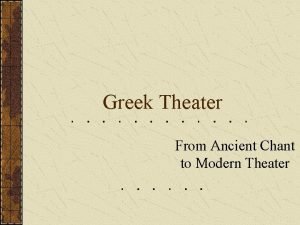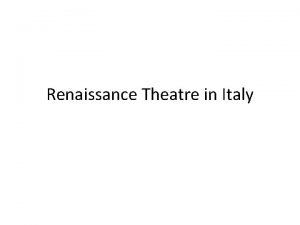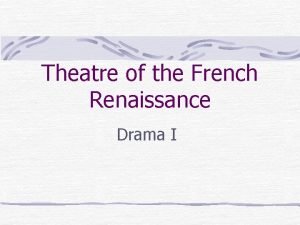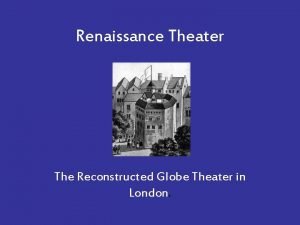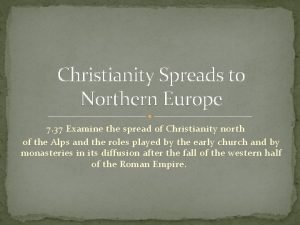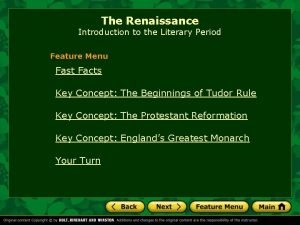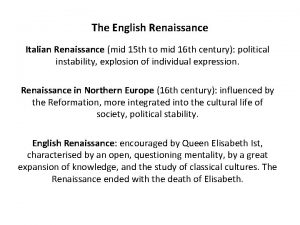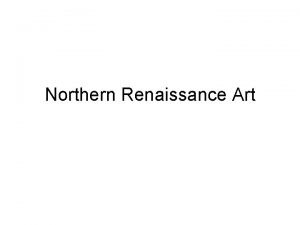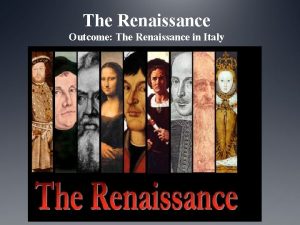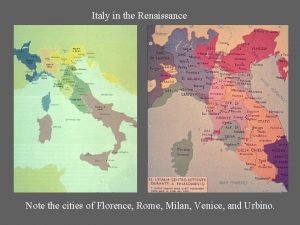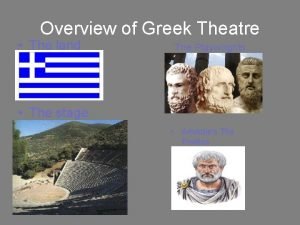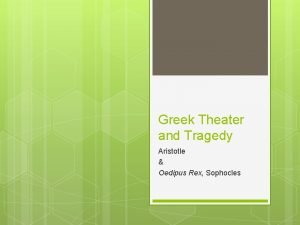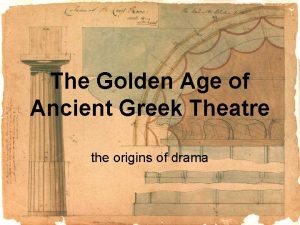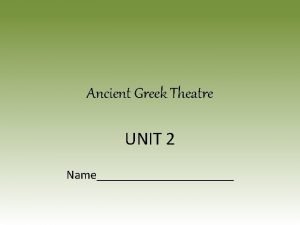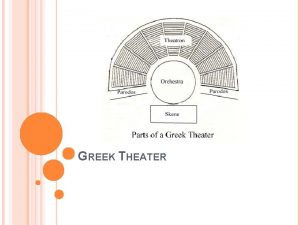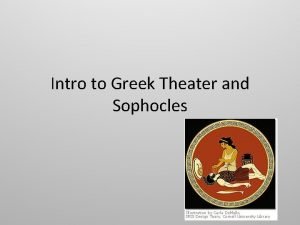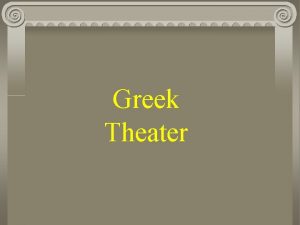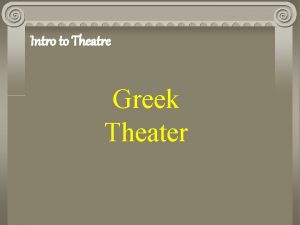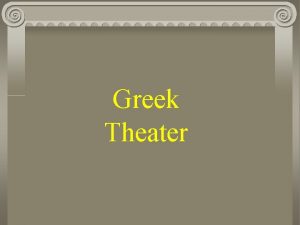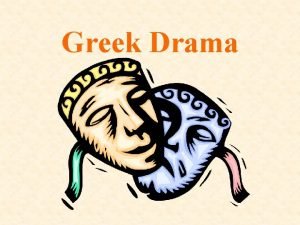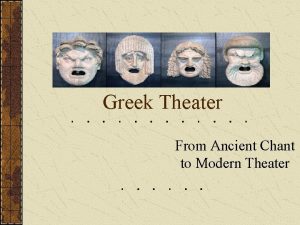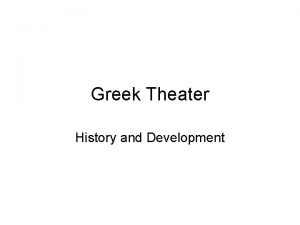EVOLUTION OF THEATER GREEK VS RENAISSANCE GREEK THEATER















- Slides: 15

EVOLUTION OF THEATER GREEK VS. RENAISSANCE

GREEK THEATER (FROM 7 TH CENTURY B. C. ) • Created to celebrate religious festivals in honor of Dionysus (a fertility god). • Chorus chanted lines from an “orchestra” as opposed to on a raised platform. • Masks used to allow the actors to play more than one character and to portray desired emotion. • High-soled boots added height but limited movement. • Amphitheater built into a hillside, sometimes seated 20, 000 people.

GREEK THEATER CONT. Masks “Masks”. Online Image. 14 April 2015. <http: //www. maskdesign. net/wpcontent/uploads/2012/02/Greek-Theater-Masks. jpg>. Chorus “Chorus”. Online Image. 14 April 2015. <http: //www. wou. edu/~aarndt 08/myweb /Chorus. html>.

STRUCTURE OF GREEK THEATER “Greek Theater”. Online Image. 14 April 2015. <http: //archive. news. softpedia. com/news/The-Mystery-of-Modern-Acoustic-in-Ancient-Greek. Theatre-Solved-51278. shtml>.

GREEK THEATER CONT. • Greek tragedies based on popular myths. • Characters struggle against hostile forces ending in defeat and ultimately death. • A series of dramatic episodes separated by choral odes (mini-songs). • Originally, rarely more than three actors on stage (chorus). • Hundreds of Greek tragedies written. Fewer than 35 remain.

CHORAL ODES (INTERLUDES) • Delivered in dithyrambs (homage to Dionysus) • 2 parts: • Strophe: “turn” or 1 st side of argument. Dance right to left. • Antistrophe: “turn back” or 2 nd side of argument. Dance left to right. (Think point and counter-point) • Epode: “after song”. Not always included. Typically in different meter. Strophe and antistrophe unite. Two opposing sides often make the correct decision difficult for the audience to discern. Example of Chorus (Antistrophe at 1: 10)

GREEK THEATER: KEY CONTRIBUTORS • Thespis (534 B. C): created the first “actor” who broke away from the chorus and would speak to the chorus as an individual character. This is why actors are also known as “Thespians”. • Aeschylus: introduced the idea of using a second and third actor which allowed for interaction between characters. • Sophocles: used chorus less to create more dialogue between characters. • Euripides: introduced naturalism and psychology including exploring the portrayal of women.

RENAISSANCE THEATER • Renaissance=Rebirth (classical arts, literature, etc. ) • 16 th Century, England’s government swung back and forth from Catholicism to Protestantism. • Plays written in Latin supported the Catholic Church. • Revival of Greek plays were associated with Protestantism. • Depending on who was in power at the time, a playwright could be put to death for reviving the “wrong” play.

FORMS OF RENAISSANCE DRAMA • TRAGEDY: begin in relative peace, then lead to the downfall of a prominent figure. • COMEDY: begin with disorder/conflict, then lead to happiness (often marriage) through unrealistic circumstances. • PASTORAL: a love story, featuring romanticized characters such as shepherds and shepherdesses, nymphs and satyrs, in an idealized rural setting. • HISTORIES: Focused on prevalent ruling families from history and historic feuds for power.

THE GLOBE THEATRE WHERE SHAKESPEARE’S PLAYS WERE PRESENTED • Circular or octagonal structures • Three stories with an open roof • Raised platform stage surrounded by the audience on the three sides • All classes represented in audience (affordable)

THE GLOBE

FLAGS FLYING ATOP A THEATRE • Signified a play was being performed • White= comedy • Black= tragedy • Red= history “Famous London Landmarks”. Online Image. 14 April 2015. <https: //www. pinterest. com/ pajudeanka/famous-london-landmarks/>.

RENAISSANCE METER • • • Iambic pentameter 2 syllables to each beat, 5 beats per line 10 syllables in each line, stress put on the 2 nd beat Sonnets Blank verse, rhymed verse, some prose (servants)

OFF-SHOOT OF RENAISSANCE COMEDY • Commedia dell’ arte = improvisation. • Originated in Italy in the 1560 s. • Very popular. • Utilized stock characters (archetypes). • Coined term “slapstick” = wooden stick used as a weapon that made a loud noise for effect. “Slapstick Characters”. Online Images. 14 April 2015. < http: //www. telegraph. co. uk/expat/ expatpicturegalleries/9254141/Punch-and-Judy-turn-350 -in-pictures. html>.

YOUR TASK Illustrate/recreate the Greek amphitheater and actors/chorus. 1. Draw the amphitheater. 1. Carved out of hillsides and held as many as 20, 000 people. 2. Small stage and stadium seating. 3. Small building behind the stage for actors to change. 2. Draw the characters/chorus. 1. Typically three characters. 2. Masks that overtly display emotion. 3. Elaborate robes consistent with social station (king vs. peasant). 4. Platform shoes to make character appear larger.
 Greek theater vs modern theater
Greek theater vs modern theater Italian renaissance theater
Italian renaissance theater French renaissance theater
French renaissance theater Globe theater renaissance
Globe theater renaissance Italian renaissance vs northern renaissance venn diagram
Italian renaissance vs northern renaissance venn diagram The renaissance introduction to the renaissance answer key
The renaissance introduction to the renaissance answer key The renaissance outcome renaissance painters/sculptors
The renaissance outcome renaissance painters/sculptors Italian renaissance vs english renaissance
Italian renaissance vs english renaissance Italian renaissance vs northern renaissance
Italian renaissance vs northern renaissance The renaissance outcome the renaissance in italy
The renaissance outcome the renaissance in italy Outcome of renaissance
Outcome of renaissance Last supper labeled
Last supper labeled First actor in greek theatre
First actor in greek theatre Chorus definition
Chorus definition Orchestra greek theatre definition
Orchestra greek theatre definition Greek amphitheatre diagram
Greek amphitheatre diagram
